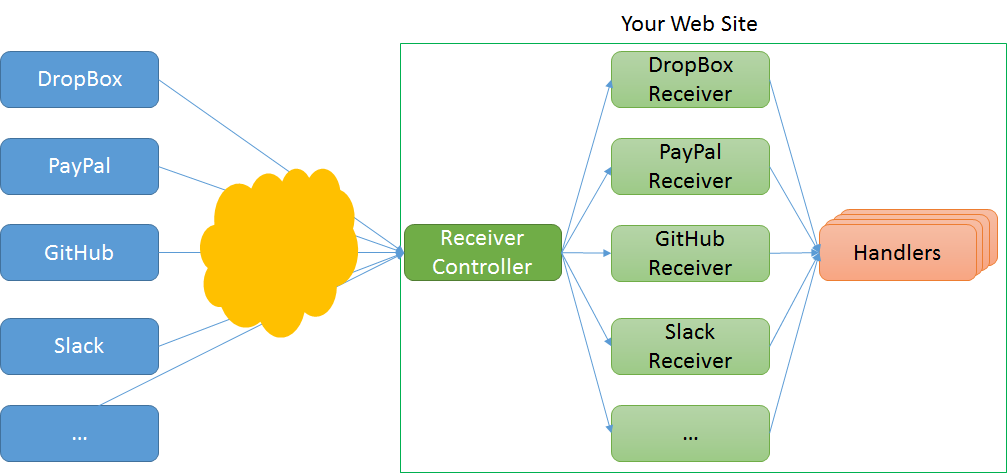ASP.NET WebHooks overview
WebHooks is a lightweight HTTP pattern providing a simple pub/sub model for wiring together Web APIs and SaaS services. When an event happens in a service, a notification is sent in the form of an HTTP POST request to registered subscribers. The POST request contains information about the event which makes it possible for the receiver to act accordingly.
Because of their simplicity, WebHooks are already exposed by a large number of services including Dropbox, GitHub, Bitbucket, MailChimp, PayPal, Slack, Stripe, Trello, and many more. For example, a WebHook can indicate that a file has changed in Dropbox, or a code change has been committed in GitHub, or a payment has been initiated in PayPal, or a card has been created in Trello. The possibilities are endless!
Microsoft ASP.NET WebHooks makes it easier to both send and receive WebHooks as part of your ASP.NET application:
On the receiving side, it provides a common model for receiving and processing WebHooks from any number of WebHook providers. It comes out of the box with support for Dropbox, GitHub, Bitbucket, MailChimp, PayPal, Pusher, Salesforce, Slack, Stripe, Trello,WordPress and Zendesk but it is easy to add support for more.
On the sending side it provides support for managing and storing subscriptions as well as for sending event notifications to the right set of subscribers. This allows you to define your own set of events that subscribers can subscribe to and notify them when things happens.
The two parts can be used together or apart depending on your scenario. If you only need to receive WebHooks from other services then you can use just the receiver part; if you only want to expose WebHooks for others to consume, then you can do just that.
The code targets ASP.NET Web API 2 and ASP.NET MVC 5 and is available as OSS on GitHub.
WebHooks Overview
WebHooks is a pattern which means that it varies how it is used from service to service but the basic idea is the same. You can think of WebHooks as a simple pub/sub model where a user can subscribe to events happening elsewhere. The event notifications are propagated as HTTP POST requests containing information about the event itself.
Typically the HTTP POST request contains a JSON object or HTML form data determined by the WebHook sender including information about the event causing the WebHook to trigger. For example, an example of a WebHook POST request body from GitHub looks like this as a result of a new issue being opened in a particular repository:
{
"action": "opened",
"issue": {
"url": "https://api.github.com/repos/octocat/Hello-World/issues/1347",
"number": 1347,
...
},
"repository": {
"id": 1296269,
"full_name": "octocat/Hello-World",
"owner": {
"login": "octocat",
"id": 1
...
},
...
},
"sender": {
"login": "octocat",
"id": 1,
...
}
}To ensure that the WebHook is indeed from the intended sender, the POST request is secured in some way and then verified by the receiver. For example, GitHub WebHooks includes an X-Hub-Signature HTTP header with a hash of the request body which is checked by the receiver implementation so you don’t have to worry about it.
The WebHook flow generally goes something like this:
The WebHook sender exposes events that a client can subscribe to. The events describe observable changes to the system, for example that a new data item has been inserted, that a process has completed, or something else.
The WebHook receiver subscribes by registering a WebHook consisting of four things:
A URI for where the event notification should be posted in the form of an HTTP POST request;
A set of filters describing the particular events for which the WebHook should be fired;
A secret key which is used to sign the HTTP POST request;
Additional data which is to be included in the HTTP POST request. This can for example be additional HTTP header fields or properties included in the HTTP POST request body.
Once an event happens, the matching WebHook registrations are found and HTTP POST requests are submitted. Typically, the generation of the HTTP POST requests are retried several times if for some reason the recipient is not responding or the HTTP POST request results in an error response.
WebHooks Processing Pipeline
The Microsoft ASP.NET WebHooks processing pipeline for incoming WebHooks looks like this:

The two key concepts here are Receivers and Handlers:
Receivers are responsible for handling the particular flavor of WebHook from a given sender and for enforcing security checks to ensure that the WebHook request indeed is from the intended sender.
Handlers are typically where user code runs processing the particular WebHook.
In the following nodes these concepts are described in more details.
 )
)
|
|